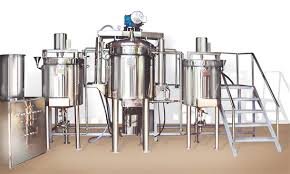Introduction
Ointments are a vital component of the pharmaceutical and cosmetic industries, used for therapeutic, protective, and cosmetic applications. The manufacturing of ointments requires specialized equipment, standardized processes, and strict adherence to regulatory guidelines to ensure product quality and safety. This article explores the key processes, essential equipment, and best practices involved in ointment manufacturing plants.
Understanding Ointment Manufacturing
Ointment manufacturing involves blending active pharmaceutical ingredients (APIs) with a suitable base to create a smooth, homogeneous semi-solid formulation. These bases can be oleaginous, water-soluble, or emulsified, depending on the desired characteristics of the final product. The manufacturing process typically consists of several key steps:
- Ingredient Selection and Preparation
- APIs and excipients (such as emulsifiers, preservatives, and stabilizers) are carefully selected based on formulation requirements.
- Ingredients are weighed and pre-mixed to achieve uniformity before being introduced into the manufacturing process.
- Mixing and Homogenization
- Ointment production requires thorough mixing to ensure the even distribution of APIs.
- Homogenization ensures the smoothness and stability of the ointment by breaking down particles to a fine consistency.
- Heating and Cooling
- Depending on the formulation, ingredients may need to be heated to facilitate mixing.
- Controlled cooling ensures the ointment solidifies with the desired consistency and stability.
- Emulsification (if required)
- In emulsion-based ointments, oil and water phases must be combined using emulsifiers to form a stable mixture.
- Filling and Packaging
- Once the ointment is prepared, it is transferred to storage tanks and then filled into tubes, jars, or containers.
- Packaging is done under sterile conditions to prevent contamination and preserve product efficacy.
Essential Equipment in Ointment Manufacturing Plants
Modern ointment manufacturing plant are equipped with specialized machinery designed to optimize efficiency and maintain product quality. Key equipment includes:
- Mixing and Homogenizing Equipment
- Planetary Mixers: Used for blending and mixing ointment ingredients efficiently.
- High Shear Homogenizers: Ensures uniformity and smooth texture by reducing particle size.
- Heating and Cooling Systems
- Jacketed Kettles: Used for controlled heating and cooling during formulation.
- Heat Exchangers: Maintains optimal temperatures during manufacturing.
- Storage and Transfer Equipment
- Stainless Steel Tanks: Store bulk ointment formulations before packaging.
- Pumps and Pipelines: Facilitate the transfer of materials between processing stages.
- Filling and Packaging Machines
- Tube Filling Machines: Automatically fill ointments into tubes with precision.
- Jar Filling Machines: Suitable for ointments packaged in jars.
- Labeling and Sealing Machines: Ensure proper packaging and tamper-proof sealing.
- Quality Control Equipment
- Viscosity Testers: Measure the consistency and spreadability of the ointment.
- pH Meters: Ensure the pH level is within the desired range for skin application.
- Microbial Testing Equipment: Detects potential contamination in the final product.
Best Practices for Ointment Manufacturing Plants
To ensure efficiency, consistency, and compliance with industry standards, ointment manufacturing plants should adopt best practices, including:
- Compliance with Regulatory Standards
- Follow Good Manufacturing Practices (GMP) and guidelines set by regulatory authorities such as the FDA, WHO, and EU GMP.
- Maintain proper documentation for each batch to ensure traceability and compliance.
- Quality Control and Assurance
- Conduct rigorous quality checks at each stage of production.
- Implement in-process controls to detect deviations from formulation standards.
- Perform stability testing to ensure product longevity and effectiveness.
- Hygiene and Cleanliness
- Maintain a sterile environment to prevent contamination.
- Regularly clean and sanitize equipment and manufacturing areas.
- Ensure personnel adhere to hygiene protocols, including wearing protective gear.
- Process Optimization and Efficiency
- Use automated equipment to improve efficiency and reduce human errors.
- Implement real-time monitoring systems for quality control and process optimization.
- Train staff regularly on best practices and technological advancements.
- Sustainability and Waste Management
- Implement eco-friendly practices, such as reducing water and energy consumption.
- Utilize biodegradable or recyclable packaging materials.
- Develop waste management protocols to minimize environmental impact.
Challenges in Ointment Manufacturing
Despite advancements in technology, ointment manufacturing plants face several challenges, including:
- Maintaining Consistency
- Achieving uniformity in texture and composition across batches can be challenging.
- Regulatory Compliance
- Keeping up with evolving regulations requires continuous updates to manufacturing practices.
- Equipment Maintenance
- Regular maintenance is essential to prevent downtime and ensure production efficiency.
- Raw Material Quality Variations
- Ensuring consistent quality in raw materials is crucial for maintaining product standards.
Conclusion
Ointment manufacturing plants play a crucial role in the pharmaceutical and cosmetic industries. By following standardized processes, utilizing advanced equipment, and adhering to best practices, manufacturers can ensure high-quality, safe, and effective ointments. Continuous improvements in technology and adherence to regulatory requirements will further enhance efficiency and product consistency, making ointment production more reliable and sustainable in the long run.
